Wikipedia
R.H. Allen:
Star Names
Ian Ridpath:
Star Tales
Universe Guide
Sea and Sky:
Constellations
IAU
Map
|
Wikipedia |
R.H. Allen: Star Names |
Ian Ridpath: Star Tales |
Universe Guide |
Sea and Sky: Constellations |
IAU Map |


|
|
Myths about the ConstellationEridanusThe River |
|


| Eridanus is a constellation in the southern celestial hemisphere. Its name represents a mythical river. |


Eridanus is one of the 48 original Ptolemaic Constellations.
 The name Eridanus (Ἠριδανός) was coined by Aratus of Soli, who between 275 and 250 BC rewrote the first comprehensive star catalogue, called Phaenomena, which was developed by Eudoxus of Cnidus about 100 years earlier.  Other Greek astronomers, including Ptolemy, used the name Potamos (Ποταμός), which is Greek for river. In Ptolemy's Almagest, the constellation is listed as Potamos.  Source:Ian Ridpath Eventually, Aratus' name was more popular than Ptolemy's and in all illustrated descriptions of the constellations, dating back at least to the Leiden Aratea use the name Eridanus. |
 Eridanus (underneath Orion) in "Atlas Coelestis"
Eridanus (underneath Orion) in "Atlas Coelestis"John Flamsteed, 1753 Source: Atlas Coelestis
|

 Eridanus as River God
Eridanus as River GodLeiden Aratea, 816 Source: Ian Ridpath |
 Eridanus as River God
Eridanus as River GodManuscript Harley 647, 9th century Source: British Library |
 Eridanus as a River
Eridanus as a RiverAl-Sufi: Book of Fixed Stars, 964 Source: Wikimedia |


|
|
Greek Mythology
In Greek mythology, Eridanus is the river carved by Phaethon. Phaethon was the son of Sun God
Helios. One day, Phaeton begged his father to let him ride the sun chariot. Helios urged him to be cautious, but
Phaeton lost control of the chariot and veered so wildly in different directions, that both heaven and earth caught fire. Zeus
brought an end to the ordeal, striking Phaethon with a thunderbolt and have him crash down to earth.
Extended versions of the Phaeton myth can be found at |

|


|
India
In Indian Astronomy, Eridanus is depicted as a sacred river, originating below
the head of Nataraja, which is the constellation Orion. In
Sanskrit, it is called Srotaswini, which means stream or current. It is commonly
depicted as the river Ganges.
|


|
China In Chinese, Eridanus is written 波江座 |
In Chinese astronomy, the northern part of Eridanus is placed in the quadrant
of the White Tiger of the West.
 The stars from Gamma Eridani via Delta and Eta to Tau-9 formed the constellation Tianyuan, the celestial fields. According to Ian Ridpath, these were animals were sacrificed to the gods, or alternatively where animals were reared for hunting.  The southern part of Eridanus cannot be seen from China. Chinese astronomer Xu Guangqi, who introduced Western astronomy to China in the late 16th century created a list of Southern_Asterisms, in which Eridanus was called Shuǐ Wěi, which means Crooked Running Water.  according to Ian Ridpath, the stars between Upsilon-1 and Kappa Eridani represented "the celestial orchard full of fruit trees, possibly the orchard of Xi Wang Mu, the Chinese Goddess of immortality."  Sources: Wikipedia, Ian Ridpath
|
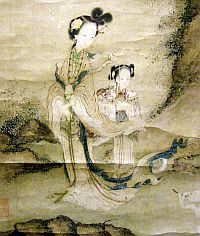 Xi Wang Mu, Painting by Xie Wenli
Xi Wang Mu, Painting by Xie Wenlibetween ca. 1751 and 1800 Source: Wikipedia
|

Ian Ridpath also tells us, that "... running from north to south along the present-day
borders with Orion and Lepus was a chain of nine stars called Jiuliu or Jiuyou, nine flags or banners of the Emperor that formed part
of the hunting scene visualized in this area.
 Next to Jiuliu in northern Eridanus was a loop of nine stars forming Jiuzhou shukou, representing interpreters for visitors to the hunt from far-off regions.  Beta, Psi, and Lambda Eridani were joined with Tau Orionis to make a square next to Rigel called Yujing, the jade well for exclusive use by the nobility; the well for ordinary soldiers, Junjing, was to the south in Lepus.  Source: Ian Ridpath
|
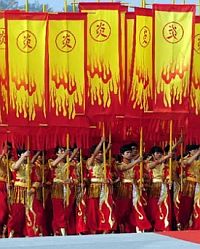 Chinese imperial banners
Chinese imperial bannersSource: imperialchinesecourt
|


| Africa |

|
|
Bedoin
According to the Arab star name expert Paul Kunitzsch,
Bedouin Arabs visualized present-day
Achernar (α Eridani) and
Fomalhaut (α Piscis Austrinus) as a pair of ostriches.
|

|


|
Sotho, Tswana,
Vendaa
Achernar (α Eri), the brightest star in the constellation Eridanus is called
Senakane
(Sotho, Tswana) and Tshinanga (Venda), meaning the Little Horn.
|

|


| Australia |

|
Boorong
The Boorong in north-western Victoria call Achernar
(α Eridani) Yerredetkurrk, which is also the name of the owlet nighgar, a small,
nocturnal bird. According to Robert Mathews, the owlet nighgar is the patron saint
of all women.
|
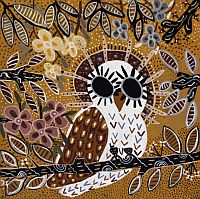 Owl
Owl© Betty Bundamurra
|
Yerredetkurrk is highest in the sky between September to December - the breeding season of the owlet nightjar. At that time, Totyarguil
cannot be seen. Totyarguil returns to the sky in late summer, when Yerredetkurrk is only very dim above the southern horizon.
 Source: John Morieson B.A: The Night Sky of the Boorong |

Another Boorong leged tell us about a feud between Yerredetkurrk and her son-in law:
 One time, Totyarguil's family was stuck on a mountain top that was too steep to climb down. Totyarguil called out to his wife and children to jump down, one by one, and he would catch them in his arms. He caught all of them safely, but when Yerredetkurrk jumped, he pretended he could not catch her, and she fell heavily on the ground. She recovered, but surely held a grouch.  Some time late, Yerredetkurrk spotted a vicious creature in a water hole. She covered the hole over with leaves and grass to resemble a huge bandicoot's nest. She then tricked Totyarguil to enter the nest to retrieve the animals. Totyarguil fell into the water hole and the monster at the bottom caught hold of his feet and drowned him. Luckily for Totyarguil, his uncle Collenbitchick came to his rescue and managed to revive him.  Source: Morieson |


|
|
Wati
To the Wati in the Western Desert, Canopus (α Carinae), the second brightest star in the night sky
and Achernar (α Eridani) are the fires of two
sky heroes, which are represented by the Magellanic Clouds.
|
 Fire Dreaming
Fire Dreaming© Jorna Newberry |

|
|
Warnindhilyagwa
The Warnindhilyagwa live far away from the Wati at Groote Eylandt in the Northern Territory, but to them too,
Achernar (α Eridani is the
fire of spirits represented by the Magellanic Clouds. For the Warnindhilyagwa , the Clouds represent the Jukara, an old man and an old woman
who cannot gather their own food.
|


|
|
Modern Day Fiction
In some maps of the Star Trek universe, the planet Vulcan
is shown to orbit 40 Eridani.
|
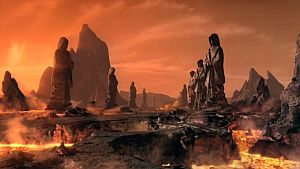 Artist's concept of the Star Trek universe planet Vulcan
Artist's concept of the Star Trek universe planet VulcanSource: denofgeek.com |

Part of The Art of the Impossible,
a 2003 novel of Star Trek: The Lost Era takes place in the
Cursa System, the (fictive) planetary system of
planet of Cursa (β Eridani).
 The system is controlled by the Klingon Empire, and is attacked by the Cardassian Union in the year 2333.  Source:Wikipedia |
 Cursa System
Cursa SystemStar Trek Gamepedia |

The location of The Vengeance Factor, a 1989 episode of
Star Trek: The Next Generation is
Acamar III, the (fictive) third
planet of Acamar (θ Eridani), where the crew learns of a group of
Acamarian nomadic pirates known as the Gatherers.
 Source:Wikipedia |
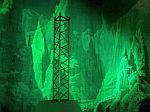 Acamar III
Acamar IIImemory-alpha.fandom.com |

In the Dune universe by
Frank Herbert, "Eridani A" is orbited by the planet Richese (the fourth planet in orbit).
Richese and Ix are "supreme in machine culture"; their devices are commonplace and considered essential throughout the Dune universe.
 Source:Wikipedia |
 Dune: House Atreides
Dune: House AtreidesSource: amazon.com |


|
Back to Star Lore |
Back to Mythology |
Back to Space Page |
Back to English |
 Back to Start Page |